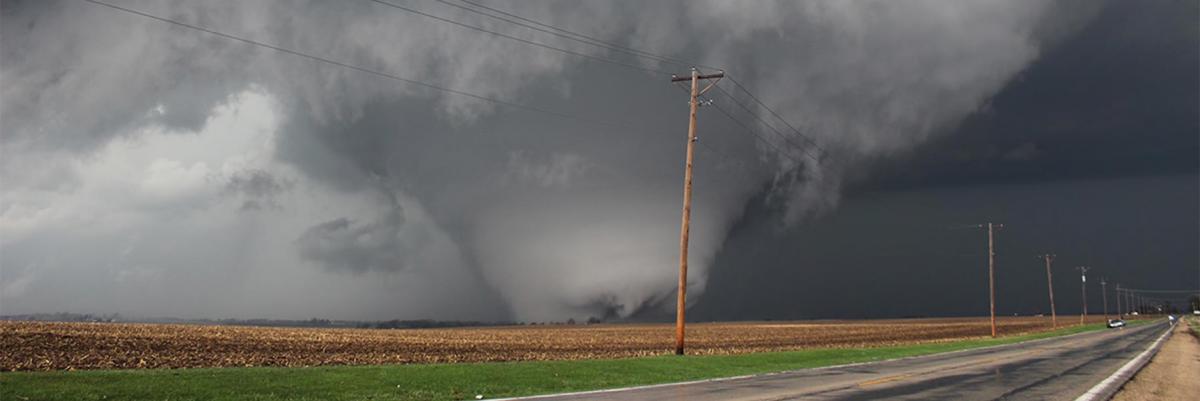Most of Illinois is prone to often catastrophic tornadoes, staight line winds, and other high wind events. The Illinois Manufactured Housing Association (IMHA) offers the following basic information about manufactured homes and high wind safety.
Everyone should understand that a direct hit from a tornado will bring about severe damage or destruction to any stucture in its path regardless of the type of construction.
But contrary to what you may have heard, by using the very same building materials and employing state-of-the-art construction processes along with rigorous quality-control inspections all factory-built homes are generally higher in quality than anything achievable with typical on-site construction.
Every new manufactured home sold today is installed by a trained installation professional. And every new home is further required to be inspected and verified for proper installation by a building code official or similar code enforcer.
A properly installed and maintained manufactured home may fair as well or better than neighboring stick-built homes when stressed by wind. However, there are three important steps to preparing a manufactured home for wind storms and events.
First, know the age of your home and know what wind level the home was designed to withstand
Locate the data plate - every manufactured home built and installed after 1976 should display a data plate near the utility closet or breaker panel that will state what wind zone the home was built for. Manufactured homes placed in Illinois (HUD Wind Zone I) after 1976 were constructed to withstand sustained wind gusts of 80 miles per hour (MPH).
Locations exposed to heavier winds such as lake side or near unbroken farmland are prone to additional exposure and many owners may wish to consider purchasing a Wind Zone II rated home for winds up to 100 MPH.
Homes built before 1976 may not have a data plate or wind zone rating.
Second, verify that your home was installed properly
Any licensed manufactured home installer, engineer or certified home inspector can perform an inspection of an existing manufactured home. Find a listing of licensed installers and knowledgeable inspectors under “Resources” at www.imha.org
Most manufactured homes are anchored by the frame to the ground, or a foundation, by a series of steel anchors able to withstand at least 4,725# of uplift each. The amount of tie down anchors required depends on the type of foundation, soil characteristics and on the size of the home. Your manufacturer’s installation manual has guidelines for you to check. Your local building official may also have recommendations to consider.
The anchors are then connected to the heavy steel main frame that the house rests on by galvanized metal straps certified to ASTM D 3953-97. The combination of straps and anchors provide protection from both uplift and horizontal movement for the home during wind or seismic events.
There are also newer anchoring systems available that not only meet code requirements, they are considerably easier to install. If you haven’t re-examined your homes anchoring system, you need to immediately.
In far too many cases, manufactured homes are damaged due to the failure of carports, patio covers, awnings, and similar after-market additions that catch the wind and impose pressures on the home well beyond the intended design load. Those attachments can sometimes break free during high wind events, not only damaging your home but the flying debris can also cause significant damage to surrounding homes or property.
The Insurance Institute for Business & Home Safety (IBHS), in conjunction with the American Modern Insurance Group, has conducted a series of tests to evaluate the effect of high winds, such as those experienced during hurricanes, low level tornadoes and severe thunderstorms, on attached structures to manufactured homes.
Third, do your own annual home maintenance inspections
With any form of home ownership comes the responsibility for preventative maintenance.
Homeowners should inspect the anchors and piers beneath their home annually. In fact the Illinois Mobile Home Tie down Act states that “The owner of each mobile home installed in Illinois…, shall be responsible to insure that approved tiedown equipment is obtained and used to secure the mobile home to the surface upon which it rests”. Maintenance after the installation is the home owner’s responsibility, too.
During the inspection you should check to ensure that there is no slack or play in any of the anchor straps. Rust or deformations can be bad signs signaling a need to replace either the anchor or the strap. While under the home, look for gaps between piers and frame members, loose shims and cracked pier blocks. Replace and repair as necessary.
Always Seek Safety
Today’s weather forecasting technologies often provide advance notice of conditions capable of producing severe wind and tornadoes. Almost everyone has a cell phone that will issue weather elated alerts. Purchasing a weather alert radio is an inexpensive way to stay informed and a good idea.
If a manufactured home has a below-ground basement, the home's residents should seek shelter there. If any home, site-built or manufactured, does not have a belowground basement, the residents should seek immediate below-ground or other appropriate shelter from the storm's possible effects.
What every family needs to know is that the only safe place to be during a tornado is in a proper shelter.




